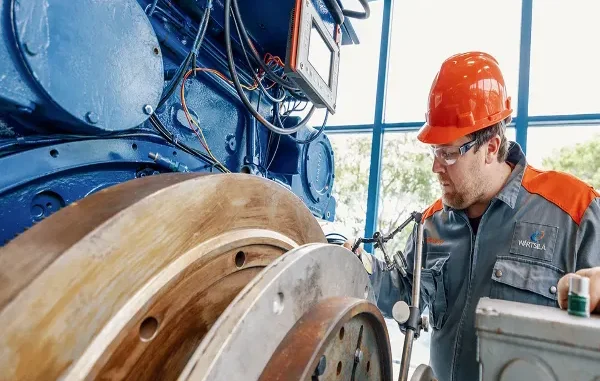

Two-stroke and four-stroke diesel and gas engines are important to marine propulsion, and their performance depends heavily on how well they are monitored and maintained. This article outlines practical solutions that support efficiency and engine reliability throughout long operating periods. The aim is to clarify how consistent maintenance supports stable operation and extended engine life.
Understanding Engine Types and Maintenance Needs
Two-stroke and four-stroke engines differ in their combustion cycle, and that means that they have different maintenance requirements.
A two-stroke engine produces power in two piston strokes, placing significant mechanical stress on the cylinder liners, piston rings, and exhaust system. Rigorous monitoring of surface condition and wear is therefore essential. A four-stroke engine, on the other hand, distributes the load over four phases. Particular attention should therefore be paid to the condition of the valves, their seats, and the components of the injection system.
Gas and diesel engines also differ in terms of combustion temperature and fuel delivery behavior, which affects deposit formation and precision of the injection system. By identifying areas of stress accumulation, it is possible to plan maintenance at appropriate intervals and avoid unnecessary dismantling. Therefore customized marine solutions are required, including appropriate diagnostic tools and methods.
Performance Monitoring Systems
Modern performance monitoring systems collect operating data from engines and auxiliary equipment to help optimize efficiency and fuel consumption. Sensors distributed throughout the propulsion system record variables such as power output, shaft torque, cylinder performance, and environmental conditions. This information can be displayed on onboard screens or on remote platforms, where it is analyzed to detect trends, deviations, or losses in efficiency.
These systems allow for adjustments to engine load, propeller pitch, and voyage planning. They thus help crews maintain stable navigation while avoiding unnecessary fuel consumption. They also offer automated reporting functions that comply with emissions and energy consumption regulations. Thanks to the clear and accessible presentation of data, maritime and industrial teams can identify areas for performance improvement and take action.
Condition Monitoring Tools
Condition monitoring tools play a crucial role in detecting wear and stress within engine components before performance issues arise.
- Cylinder liner measuring instruments allow technicians to track diameter variations, surface irregularities, and wear progression.
- Tools for assessing piston ring coatings help determine whether protective layers are intact or beginning to degrade due to heat or friction.
- Cylinder pressure indicators help balance power between different engine units, ensuring smoother operation and reduced vibration.
- Crankshaft deflection gauges detect misalignment that may indicate stress on bearings or the structure.
- Roughness gauges are used to verify that machined or honed surfaces have the required finish for optimal lubrication and sealing.
- Calibration devices for temperature and pressure instruments help ensure the accuracy of onboard measurements, thereby preventing interpretation errors during routine checks.
Regular use of this type of tools allows maintenance to be planned based on the actual condition of the system rather than on fixed cycles, thereby reducing downtime and preventing further damage.
Cleaning Systems for Engine Components
Cleaning systems designed for diesel and gas engine parts help maintain consistent performance by removing carbon deposits, oil residues, and other buildup that forms during operation. For example, water-based ultrasonic cleaning equipment uses sound waves in a cleaning fluid to reach small cavities and complex internal shapes. This method is suitable for components such as pistons, injectors, and heat exchanger parts. It provides uniform cleaning without abrasion, helping to preserve material integrity.
Spray cleaning systems, on the other hand, are ideal for large parts and routine workshop procedures. Rotating nozzles and controlled fluid pressure ensure thorough surface cleaning, while filtration systems maintain cleaning efficiency even after repeated use. Onboard as well as workshop setups can be adapted to the available space and workload, minimizing disruption to maintenance schedules.
Grinding and Machining of Cylinder Heads and Liners
Grinding and machining restore critical engine surfaces, ensuring that compression is maintained and that combustion is efficient. Valve spindles and seats, in particular, require precise grinding to guarantee optimal sealing and consistent airflow. Specialized machines are used to achieve precise alignment and a flawless surface finish. For cylinder liners, honing and deglazing are used to correct the internal geometry and recreate the surface structure, promoting lubrication and reducing friction.
Over time, wear edges can form at the top of cylinder liners due to the expansion and contraction of parts during operation. Special tools can be used to safely remove these edges, reducing the risk of damage when removing or reinstalling pistons. The sealing surfaces between the cylinder heads, liners, and engine block also benefit from in-situ machining solutions. These methods restore flatness and improve sealing without having to dismantle the engine block.
Fuel System Maintenance and Injector Testing
Finally, fuel injection systems are essential because they directly influence combustion quality, fuel efficiency, and emissions reduction. Rigorous inspection and maintenance are therefore essential. Test equipment for diesel, gas, methanol, and dual-fuel injectors can be used to check opening pressure, sealing performance, and spray pattern consistency. The condition of the fuel pump can be assessed using test equipment that measures the seal between plunger and barrel, as well as the operation of non-return valves, without requiring complete disassembly. By targeted calibration and control, stable atomization and combustion can be maintained, contributing to smooth operation and reduced wear on other engine components
Leave a Reply